On this page
Books about Tyrant FlycatchersThe books are listed in order of publication date with the most recent at the top.
Tyrant Flycatchers
Family: Tyrannidae
Tyrant Flycatcher are widely distributed across South, Central and North America.
There are over 400 species in the Tyrannidae family across about 100 genra. This includes flycatchers, tyrannulets, elaenia, bristle tyrants, scrub flycatchers, tody-flycatchers, inezias, tit-tyrants, doraditos, flatbills, spadebills, myiobius, pewees, phoebes, chat-tyrants, bush tyrants, black tyrants, monjita, attilas, sirystes and kingbirds. The tyrant flycatchers are not related to the old world flycatchers.
|
|
|
|
Handbook of the Birds of the World, Vol. 9: Cotingas to Pipits and WagtailsEdited by Josep Del Hoyo, Andrew Elliott and David Christie
Illustrations: Norman Arlott, Hilary Burn, John Cox, Ren Hathway, Ian Lewington, Chris Rose, Brian Small, Ian Willis, Tim Worfolk
Lynx Edicions
2004
850 pages, 78 colour plates, colour photos, distribution maps.
This volume covers cotingas, manakins, tyrant-flycatchers, New Zealand wrens, scrub-birds, lyrebirds, larks, swallows, pipits and wagtails.
|
Buy from amazon.co.uk 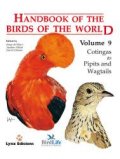
|
|
Life of the FlycatcherAlexander F. Skutch
Illustrated: Dana Gardner
University of Oklahoma
1997
"The American flycatcher is the subject of this enchanting book by a renowned ornithologist, who draws upon personal observations and extensive research to portray this family over its vast range."
|
Buy from amazon.co.uk 
|
|
The Birds of South America, Volume 2, The Suboscine PasserinesRobert S. Ridgely & Guy Tudor
University of Texas Press
1994
"The Birds of South America, projected to be a four-volume work, thus fills a critical void. Starting from a museum approach, the authors have examined specimens of each subspecies, comparing them visually and trying to discern the patterns in their plumage variation, both intra- and inter-specifically. They take a new look at bird systematics, reassessing relationships in light of new information. Perhaps most important, they combine this review and analysis with extensive field observations to give an accurate, incisive portrait of the birds in nature. At a time when rapid development is devastating millions of acres of tropical habitat in South America, this record of an endangered resource becomes crucial. If the birds and other plants and animals of South America are to be saved, they must first be known and appreciated."The Birds of South America" is a major step in that direction. Volume II includes: the Ovenbirds and Woodcreepers, Antbirds, Gnatcatchers, and Tapaculos; Tyrant Flycatchers; and Manakins and Cotingas.
|
Buy from amazon.co.uk
Buy from amazon.com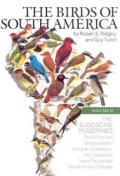
|
|
A Phylogeny Of The Flatbill And Tody-Tyrant Assemblage Of Tyrant FlycatchersWesley E. Lanyon
American Museum Novitates, No. 2923
American Museum of Natural History
1988
From the abstract: "A phylogeny is developed for those tyrant flycatchers known variously as flatbills, tody-tyrants, and pygmy-tyrants. Historically these flycatchers have been assigned to three different subfamilies, but an argument is presented here for their monophyly based on shared derived states of the nasal septum, interorbital septum, and nest form. Putative relatives that do not share these derived states are excluded from this assemblage: Ramphotrigon and Pseudotriccus."
|
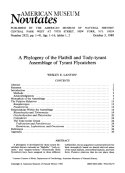 |
|
A Phylogeny Of The Thirty-Two Genera In The Elaenia Assemblage Of Tyrant FlycatchersWesley E. Lanyon
American Museum Novitates, No. 2914
American Museum of Natural History
1988
From the abstract: "Shared derived characters from cranial and syringeal morphology are the basis for the development of a phylogeny for those genera of tyrant flycatchers that make up the bulk of two of Hellmayr's (1927) subfamilies, the Serpophaginae and Elaeniinae, along with a few genera at the end of his Euscarthminae. Monophyly of this assemblage is established solely on the basis of a derived configuration of the nasal septum in which the trabecular plate is described as being within the septum."
|
 |
|
A Phylogeny Of The Thirty-Three Genera In The Empidonax Assemblage Of Tyrant FlycatchersWesley E. Lanyon
American Museum Novitates, No. 2846
American Museum of Natural History
1986
From the abstract: "Shared derived characters from cranial and syringeal morphology are the basis for the development of a phylogeny for those genera of tyrant flycatchers that make up the bulk of two of Hellmayr's (1927) subfamilies, the Serpophaginae and Elaeniinae, along with a few genera at the end of his Euscarthminae. Monophyly of this assemblage is established solely on the basis of a derived configuration of the nasal septum in which the trabecular plate is described as being within the septum."
|
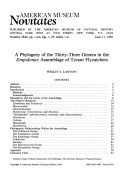 |
|
A Phylogeny Of The Kingbirds And Their AlliesWesley E. Lanyon
American Museum Novitates, No. 2797
American Museum of Natural History
1984
From the abstract: "A phylogeny is developed for those genera of tyrant flycatchers known as the kingbirds and their allies: Pitangus, Megarynchus, Myiozetetes, Conopias, Myiodynastes, Legatus, Empidonomus, Tyrannopsis, and Tyrannus. Monophyly of the assemblage
is established by two shared derived character states of the skull."
|
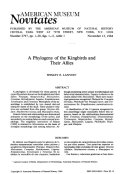 |
|
Notes On Tyrant Flycatchers (Aves, Tyrannidae)Melvin A. Traylor Jr
Fieldiana Zoology: New Series No. 13
Field Museum Of Natural History
1982
Introduction: "During the preparation of the manuscript of the Tyrannidae for Volume 8 of Peters' Check-list of Birds of the World (Traylor, 1979, pp. 1-228), a number of problems arose which required further study. Ideally, these problems should have been resolved and the results published before the appearance of Volume 8. However, in order to avoid any further delay of the volume, I included my tentative conclusions there and am publishing the justifications here. Un- fortunately, in the case of Sublegatus, subsequent studies have caused me to revise the classification presented in Peters' Check-list. The nomenclature used in this paper is that of Peters' Check-list, the rationale for which was explained in Traylor (1977)."
|

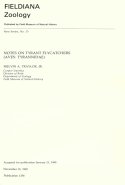 |
|
The Living BirdNineteenth Annual
The Laboratory of Ornithology
Cornell University
1981
Main contents:
- A Boreal Owl Portrait - George Miksch Sutton
- A Survey of the Tyrant Flycatchers - Melvin A. Traylor, Jr. and John W. Fitzpatrick
- The Hooded Grebe on Laguna de Los Escarchados: Ecology and Behavior - Robert W. Storer
- The Downy Young of the Hooded Grebe - Gary L. Nuechterlein and Andres Johnson
- Relationships and Speciation of the Hawaiian Thrushes - H. Douglas Pratt
- Biology and Conservation of the Bahama Parrot - Noel F.R. Snyder, Warren B. King, Cameron B. Kepler
- Notes on the Plumages of the Boat-billed Heron - Robert W. Dickerman, Kenneth C. Parkes, Joseph Bell
- The Breeding of the Pearl Kite in Trinidad - Richard P .ffrench
- The Bald Eagle Concentration in Glacier National Park, Montana: Origin, Growth, and Variation in Numbers - B. Riley McClelland, Leonard S. Young, et al
Illustrations by: George Miksch Sutton et al.
|
 |
|
Communication and Relationships in the Genus TyrannusW. John Smith
Nuttall Ornithological Club publication 6
1966
|
Buy from amazon.co.uk 
|
|
Experiments On Species Discrimination In Myiarchus FlycatchersWesley E. Lanyon
American Museum Novitates, No. 2126
American Museum of Natural History
1963
Opening lines: "The many species of flycatchers belonging to the genus Myiarchus exhibit a remarkable uniformity in plumage color and pattern. This uniformity in morphology has led to considerable confusion and disagreement among taxonomists as to the specific limits within the group. Field workers have long been cognizant of rather pronounced differences in voice among these birds, and spectrographic analyses of the differences in audio characters have been evoked in recent revisions of certain complexes within the genus (Lanyon, 1960, 1961). That these conspicuous vocal differences function as the basis for species discrimination by these birds was the hypothesis tested in the series of field experiments reported on here."
|
 |
|
Life Histories of Central American Birds II
Families: Vireonidae, Sylviidae, Turdidae, Troglodytidae, Paridae, Corvidae, Hirundinidae And Tyrannidae
Alexander F. Skutch
Illustrations: Don R. Eckelberry
Pacific Coast Avifauna Number 34
Cooper Ornithological Society
1960
From the introduction: "This volume of life histories follows closely the plan of its predecessor. The observations recorded herein were made in the same places as those which fill the first volume, in the introduction to which they are briefly described. But the studies reported here were made over a longer interval of time, extending from 1929 to 1956. Nearly all of my more recent bird watching has been done on my farm at Quizarra where I have resided since 194 1. It is on the northern side of the valley of El General which is on the Pacific slope of southern Costa Rica at an altitude of about 2500 Feet."
|
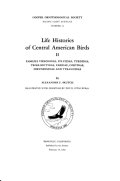
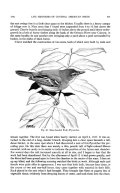 |
|
Further Notes On Tyrant Flycatchers (Tyrannidae)John T. Zimmer
American Museum Novitates, No. 1749
American Museum of Natural History
1955
|
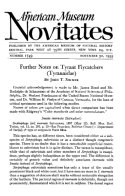 |
|
Notes On Tyrant Flycatchers (Tyrannidae)John T. Zimmer
American Museum Novitates, No. 1605
American Museum of Natural History
1953
Opening lines: "During the review of various members of the family Tyrannidae in connection with the preparation of volume 8 of the "Check-list of birds of the world," several cases have come to light that require more extended treatment than can be given them in the final volume. Those that have been studied in sufficient detail to date to justify a formal report are discussed below."
|
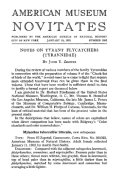 |
|
Temperature, Growth And Other Studies On Eastern PhoebeDayton Stoner
New York State Museum Circular, No. 22
University of the State of New York
1939
|
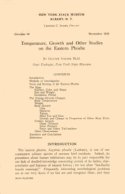 |
|
A New And Remarkable Flycatcher From GuatemalaJonathan Dwight And Ludlow Griscom
American Museum Novitates, No. 254
American Museum of Natural History
1927
Opening lines: "In the last collection just made by Mr. A. W. Anthony in the mountains of western Guatemala are two specimens of a remarkable Tyrannid, which in coloration and structural details is unique, and parallels in interest Taeniotriccus andrei in Venezuela, which also possesses unusually trenchant characters for so difficult and uniform a group. We hope at a future date to be able to secure some information regarding its haunts and habits, and perhaps to figure it-the most interesting discovery made in Central America in many years. When we unwrapped the specimens, they were quickly recognized as belonging to an undescribed species, and a few minutes' casual inspection convinced us that we were dealing with a peculiarly distinct genus."
|
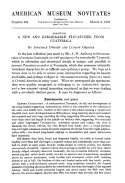 |
|
Catalogue Of The Passeriformes or Perching Birds In The Collection Of The British MuseumOligomyodae, or the Families Tyrannidae, Oxyrhamphidae, Pipridae, Cotingidae, Phytotomidae, Philepittidae, Pittidae, Xenicidae, and Eurylaemidae
Catalogue Of The Birds In The British Museum, Volume XIV
Philip Lutley Sclater
26 colour plates: J. Smit
Printed By Order Of The Trustees
Printed by Taylor & Francis
1888
From the introduction: "My ornithological studies having been principally devoted to South-American Birds, I had little hesitation in acceding to Dr. Gunther's request that I should prepare the Catalogue of the Mesomyodian Passeres in the Collection of the British Museum. Of the thirteen families that belong to this section of the Passerine group, nine are exclusively Neotropical, and these nine families embrace by far the greatest number of specific forms, the four Mesomyodian families as yet recognized in the Old World being comparatively insignificant in point of numbers. My subject was, therefore, sufficiently familiar to me. At the same time some of the groups to be treated of - I may point especially to the Tyrannidae - are universally allowed to be amongst the most difficult portions of the class of Birds for satisfactory determination. I felt, therefore, that in the short time that could necessarily be allowed me for the completion of my task I had no easy duty to perform."
|
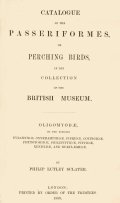
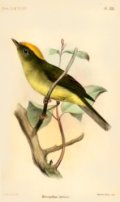
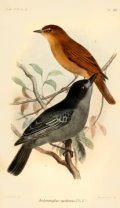 |
|